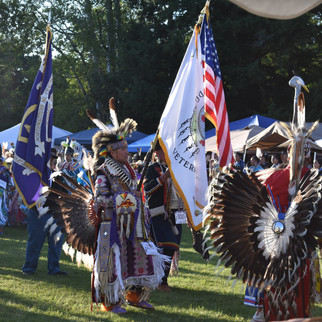Overshadowed: Discovering the roots of Little Traverse Bay
- Jessyca Stoepker

- Oct 18, 2019
- 5 min read

As many of you know, I have been accepted into and participating in events through Leadership Little Traverse, a nine-month civic engagement and professional development program. The reason I mention this is because it has turned into something completely—and wonderfully—unexpected. In addition to learning leadership, team-building, and real-world application skills, we’ve also dove head-first into the history of the Little Traverse Bay region. Though it would only make sense to understand the demographics and culture of this area first in order to improve it, I had no idea that I would become so...shocked? Invested? Inspired? by what I’m learning.
Let me back up a minute.
When you think of Petoskey and Harbor Springs, what do you think of? Here are the most common answers I and my cohort have found.
Water: the pier, beaches, shoreline, swimming, etc.
Small town charm: Gaslight shopping downtown, Roast & Toast, farmer’s markets, and festivals.
Nature and recreation: Little Traverse Wheelway, state forests and parks, hiking, biking, fall color tours, skiing, sailing, etc.
Luxury living and summer vacations: tourists, summer cottages, expensive housing associations, wine tours, and nights out at bars and restaurants along the waterfront.
What about the history of this place? Most would mention the haunted stomping grounds of Ernest Hemingway, the rail lines that brought so many visitors up from Chicago and Detroit, places like Bayview and Harbor Point, the cement and logging industries, or the chamber of commerce being a century old.
I would argue that the developments of the past hundred-or-so years have wrongfully overshadowed a critical piece to this region, and have blinded me and others from truly understanding the deep roots still interwoven beneath the surface, holding us together: the Waganakising Odawak, or the Little Traverse Bay Bands of Odawa Indians.

“Bands” is important to include here. The nine Bands are: North Shore (Naubinway west to Escanaba); the Beaver Islands; Cross Village; Burt Lake; Good Heart (Middle Village); Harbor Springs; Petoskey; Bay Shore; and Charlevoix. While the Bands represent different “subgroups,” they are considered a single governmental body under one constitution. Collectively, the Tribe has over 4,000 members, with a large number living within Charlevoix and Emmet Counties.
If you peruse their website, you’ll find a boatload of fascinating information. Did you know that during the many years of their legal disputes with the government, the Odawa often canoed all the way from Little Traverse Bay to Washington D.C., sometimes in the middle of winter? We discussed this in LLT with one tribal member, and you can see it on the LTBB’s historical timeline. It blew my mind to learn that groups of elders set off to Washington from the very shores of Zorn Park where we stood, shivering as they embarked on what would be a long, cold journey to a hostile reception at the capitol.
In my awe of these new tidbits of history, I also felt other things. Embarrassment. Privilege. Naivety.
I feel that the dialogues I have been part of in my lifetime never touched the depth of indigenous peoples’ trials and culture. And the traditional education system was appalling, to say the least. We were briefed on their traditions and stereotypes after grouping most of the tribes together. We were tested on the trading, wars, and famous battles with the English and French. We dressed up as “pilgrims and Indians” to celebrate “Thanksgiving.” I read a book about Squanto.
In college, I could perceive more color to their stories. I read more literature that stepped away from the Western perspective. I learned more about the discrimination and desecration of sacred lands. I participated in a Standing Rock Keystone Pipeline protest at the Calder Plaza and felt the weight of their emotions flow through me for a short while.
But I still didn’t feel fully comfortable in this basic understanding. It seemed like indigenous stories and points of view were pushed out of focus, shoved into a closet somewhere with a sign above the door that said, “Past Problems That Aren’t Our Fault.” Sometimes I’m sure this was unconscious bias, a product of generational denial and ignorance. Other times I’m certain this exclusion was intentional.
This past August, my friend and I attended the LTBB Homecoming Pow Wow in Harbor Springs, where I took the pictures you see on this page. The Homecoming Pow Wow showcases the Odawa traditions, ceremonial dress, singing, dancing, and cuisine. While some of the dance styles and songs are contemporary, many are very old and passed down from generation to generation.
Alexis and I stayed at the event for about two hours, intently watching the Grand Entry, the drumming teams, and then the different men's and women's dance divisions. At first, we felt a little out-of-place, and we tried our best to stay out of the other audience members' view. After all, this event wasn't about us: it was about the celebration of the tribal community and bringing all bands of the Odawa together. Over the loudspeaker, we heard that many had come from the Upper Peninsula, Wisconsin, Indiana, and Canada. Others probably came from farther away.
Soon, though, we realized it also had just as much to do with bringing the Native and non-Native communities together. We sat next to an elder under a tent, who offered his snacks to us and his answers to any questions we had. He seemed happy we were there to watch, and I was humbled by his simple openness and generosity. All audience members were invited to come into the circle to dance at times, regardless of heritage or skill. And this event was also the first time I heard the Anishinaabe language spoken, prominently; each dance competitor introduced themselves first with their tribal name and greeting, and many announcements were made in Anishinaabe. By just being there to witness the interactions and customs, I realized how large our indigenous populations are, how necessary it is to have these events, and how much I still had to learn.
I understand how it can be hard to foster an interest in another culture if you can’t immediately find a personal connection or aren’t inspired to do so. I understand how reading and learning about Native Americans, their lives, and their struggles can be unsettling to some. I feel the tension, the hesitancy, the awkwardness that comes from discussing topics previously labeled as “us versus them” debates. But those things don’t excuse us from our ignorance anymore.
I feel that, as a resident of this area and an aspiring champion of its environment and people, I am obligated to learn as much about this tribe, their history and culture, and their members as I can. I feel that this is the least I can do.
I’m looking forward to further lessons through LLT, and to expanding my understanding in my own way. And to, hopefully, share some of those discoveries here.
Thanks for reading.
Jess













Comments